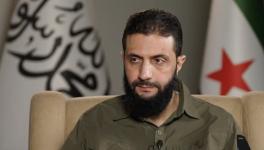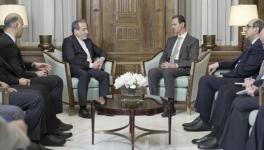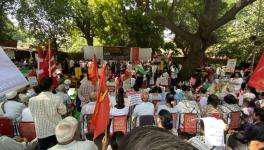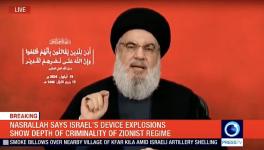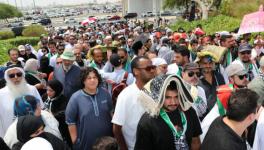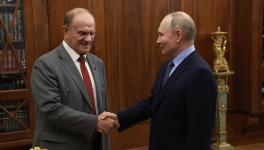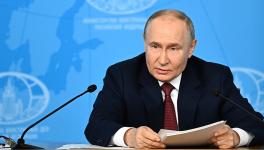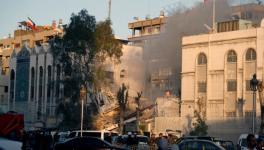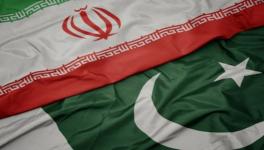10 Points on the Fall of Bashar al-Assad’s Syria
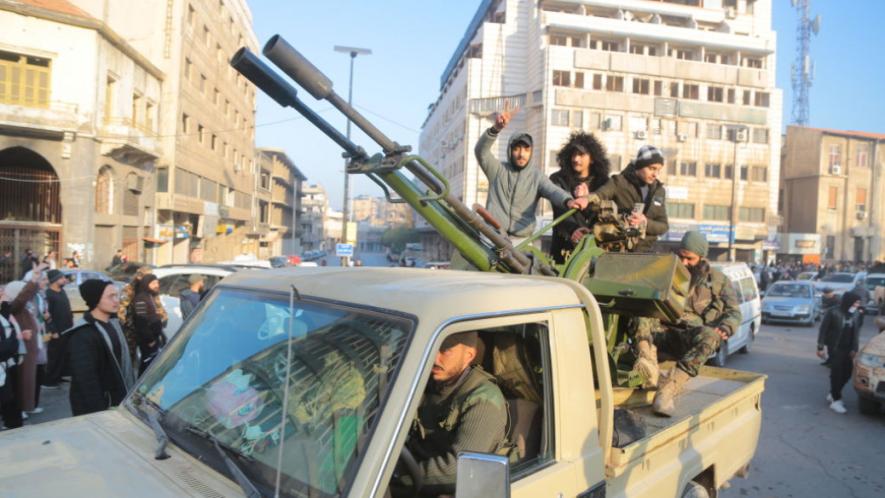
Syrian terrorist groups led by Mohammed al-Julani (former Al Qaeda leader) taking over Damascus. Photo via The New Arab
Lee en español aquí and French below.
On Sunday, December 8, after over a week of intense fighting between the Syrian government and the terrorist group Hay’at Tahrir al-Sham (HTS) and its allied factions, who gained control over key cities in the country, Syrian President Bashar al-Assad fled Syria. The news was announced by the Russian Foreign Ministry which also informed that with his resignation, al-Assad instructed his prime minister to stay in charge of the state to oversee a peaceful transition of power to opposition forces.
The development happens 14 months into Israel’s genocide in Gaza, and weeks after signing a ceasefire agreement with Hezbollah. Below are reflections from Vijay Prashad regarding the takeover and key elements to understand it.
1. The Syrian state had been devastated by the war which began 2011, and then by the sanctions placed on the country by the United States and its allies. The Syrian Arab Army (the official state army) had never fully recovered in the aftermath of the major fighting and was incapable of taking back the main cities of Hama, Homs, and Aleppo.
2. The Israeli bombardment of Syrian military facilities had weakened the Syrian armed forces’ logistical and ordinance capabilities. These attacks had been sustained and painful for the Syrian armed forces.
3. Israeli invasion of Lebanon and the assassination of Hezbollah leader Sayyed Hassan Nasrallah had weakened the ability of Hezbollah to operate even within Lebanon’s south, which forced the recent ‘ceasefire’ agreement with Israel. This demonstrated that Hezbollah was not in any position to enter Syria again to defend the Syrian government against any armed incursion on the Hama to Damascus road (highway M5).
4. The attacks on Iranian supply depots and military facilities in Syria as well as the attacks by Israel on Iran had prevented any build up of Iranian forces to defend the Syrian government. The weakening of Hezbollah also weakened Iran’s role in the region.
5. The nearly three years of conflict in Ukraine had certainly denied Syria the ability to call upon further Russian assistance for the protection of Damascus or for the Russian naval base in Latakia.
6. Therefore, Syria’s government no longer had its Iranian and Russian military allies for assistance against the reinforced rebels.
7. The Hayat Tahrir al-Sham, formed in 2017 out of the al-Qaeda formations, drew together various military forces from Turkey to the Uyghurs – with a large number of other al-Qaeda influenced fighters – and built up its forces in Idlib over the past decade. HTS has received aid and support from Turkey, but also covertly from Israel (this information came to me from a highly placed intelligence official in Turkey).
8. What will the new HTS-led government do regarding the many social minorities in Syria? What will the new HTS-led government do regarding the Golan Heights and Israel? How will the new HTS-government regard the Israeli military incursion in Quneitra?
9. This story is not over yet. There will be much further unrest in the country led by ISIS as well as the Kurdish groups in the north; already Turkish-backed groups are in combat against the Kurdish YPG (People’s Defense Units) and PKK (Kurdistan Workers’ Party) forces in Manbij; US forces are already in eastern Syria, where they say that they will remain as a buffer against ISIS (and will therefore retain control of the oil); Israel also announced that it took over the Golan buffer zone. There will be tension between the governments of Turkey and the US regarding what the new HTS-led government must, and must not do.
10. I hope very much that the statements made by Abu Mohammed al-Jolani, that retribution must not be the new culture, will come true. The real fear is regarding the treatment of the minority populations. There is no word yet if the militia groups in Iraq will enter Syria. Much of this depends on what happens to places such as the Sayyida Zaynab shrine in Damascus.
~~~~
[Français]
10 points sur la chute de la Syrie de Bashar al-Assad
Dimanche 8 décembre, après plus d’une semaine de combats intenses entre le gouvernement syrien et le groupe terroriste Hay’at Tahrir al-Sham (HTS) et ses factions alliées, qui ont pris le contrôle de villes clés du pays, le président syrien Bashar al-Assad a quitté la Syrie. La nouvelle a été annoncée par le ministère russe des affaires étrangères, qui a également indiqué qu’avec sa démission, al-Assad a demandé à son premier ministre de rester à la tête de l’État pour superviser une transition pacifique du pouvoir vers les forces de l’opposition.
Cette affaire prend lieu 14 mois après le début du génocide israélien à Gaza et quelques semaines après la signature d’un accord de cessez-le-feu avec le Hezbollah. Vous trouverez ci-dessous les réflexions de Vijay Prashad sur cette prise de contrôle et les éléments clés permettant de la comprendre.
1. L’État syrien a été dévasté par la guerre, puis par les sanctions imposées au pays par les États-Unis et leurs alliés. L’armée arabe syrienne (l’armée officielle de l’État) ne s’est jamais complètement remise des combats majeurs et a été incapable de reprendre les principales villes de Hama, Homs et Alep.
2. Les bombardements israéliens contre des installations militaires syriennes ont affaibli les capacités logistiques et militaires des forces armées syriennes. Ces attaques ont été prolongées et douloureuses pour les forces armées syriennes.
3. L’invasion israélienne du Liban et l’assassinat du chef du Hezbollah Sayyed Hassan Nasrallah ont affaibli la capacité du Hezbollah à opérer même dans le sud du Liban, ce qui a forcé le récent accord de « cessez-le-feu » avec Israël. Cela a démontré que le Hezbollah n’était pas en mesure de pénétrer à nouveau en Syrie pour défendre le gouvernement syrien contre toute incursion armée sur la route reliant Hama à Damas (autoroute M5).
4. Les attaques contre les dépôts d’approvisionnement et les installations militaires iraniens en Syrie ainsi que les attaques d’Israël contre l’Iran ont empêché tout renforcement des forces iraniennes pour défendre le gouvernement syrien. L’affaiblissement du Hezbollah a également affaibli le rôle de l’Iran dans la région.
5. Les près de trois années de conflit en Ukraine ont certainement privé la Syrie de la possibilité de faire appel à une assistance russe supplémentaire pour la protection de Damas ou de la base navale russe de Lattaquié.
6. Le gouvernement syrien ne pouvait donc plus compter sur ses alliés militaires iraniens et russes pour l’aider à combattre les rebelles renforcés.
7. Hayat Tahrir al-Sham, formé en 2017 à partir de formations d’Al-Qaïda, a rassemblé diverses forces militaires de la Turquie aux Ouïghours – avec un grand nombre d’autres combattants influencés par Al-Qaïda – et a renforcé ses forces à Idlib au cours de la dernière décennie. HTS a reçu l’aide et le soutien de la Turquie, mais aussi secrètement d’Israël (cette information m’a été communiquée par un haut responsable du renseignement turc).
8. Que fera le nouveau gouvernement dirigé par HTS à l’égard des nombreuses minorités sociales en Syrie ? Que fera le nouveau gouvernement dirigé par HTS à l’égard du plateau du Golan et d’Israël ? Comment le nouveau gouvernement HTS réagira-t-il à l’incursion militaire israélienne à Quneitra ?
9. Cette histoire n’est pas encore terminée. Il y aura encore beaucoup de troubles dans le pays, menés par l’EI (État islamique) et les groupes kurdes du nord; des groupes soutenus par la Turquie combattent déjà les forces kurdes du YPG (Unités de défense du peuple) et du PKK (Parti des travailleurs du Kurdistan) à Manbij ; les forces américaines sont déjà dans l’est de la Syrie, où elles affirment qu’elles resteront comme tampon contre l’EI (et garderont donc le contrôle du pétrole); Israël a également annoncé qu’il avait pris le contrôle de la zone tampon du Golan. Il y aura des tensions entre les gouvernements turc et américain concernant ce que le nouveau gouvernement dirigé par HTS doit faire, ou ne pas faire.
10. J’espère vivement que les déclarations d’Abou Mohammed al-Jolani, selon lesquelles le châtiment ne doit pas être la nouvelle culture, se réaliseront. La véritable crainte concerne le traitement des populations minoritaires. On ne sait pas encore si les milices irakiennes entreront en Syrie. Cela dépend en grande partie de ce qui arrivera à des endroits comme le sanctuaire de Sayyida Zaynab à Damas.
Get the latest reports & analysis with people's perspective on Protests, movements & deep analytical videos, discussions of the current affairs in your Telegram app. Subscribe to NewsClick's Telegram channel & get Real-Time updates on stories, as they get published on our website.









